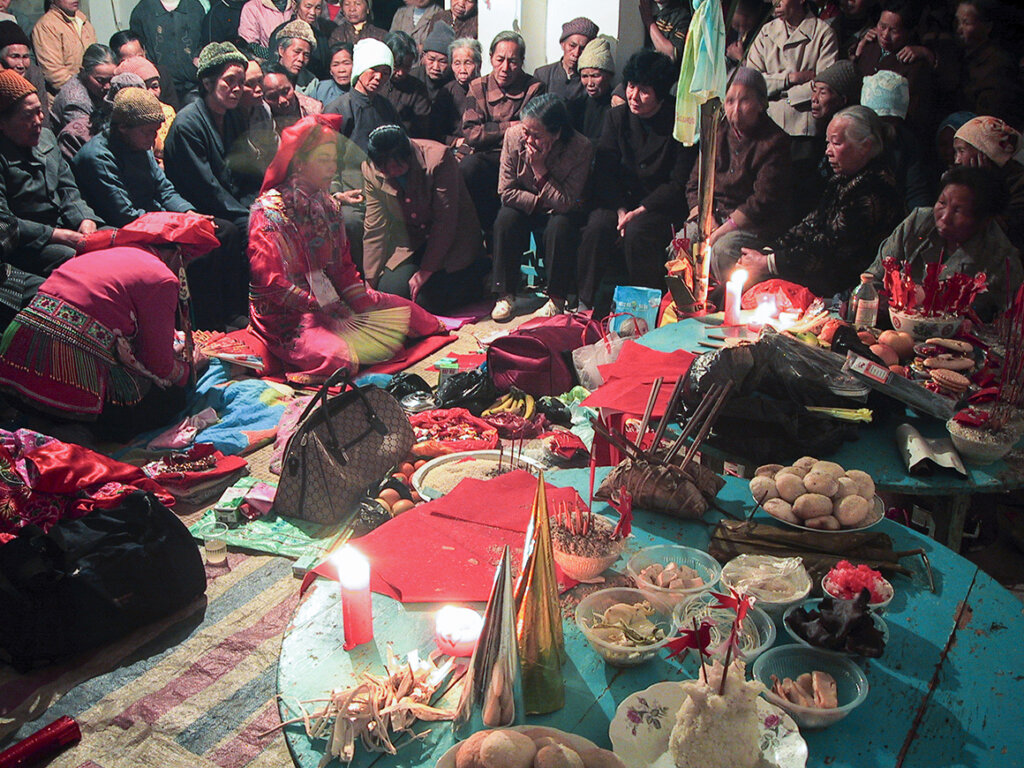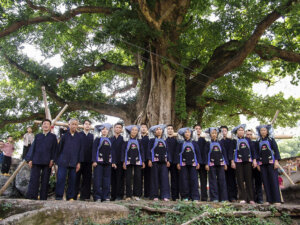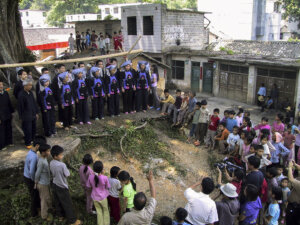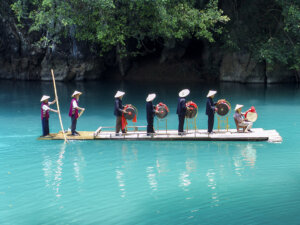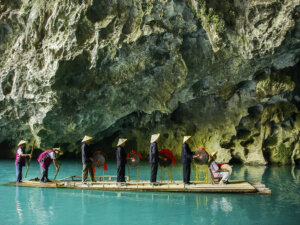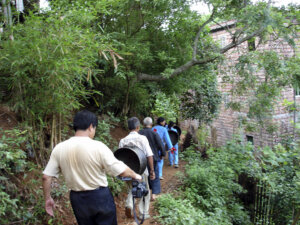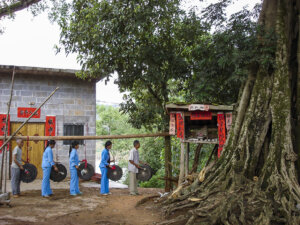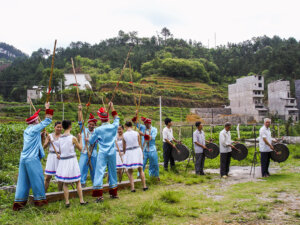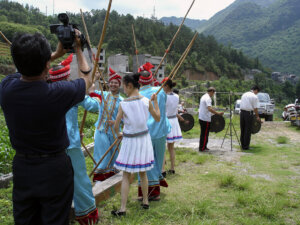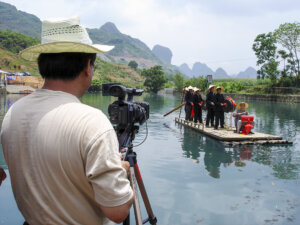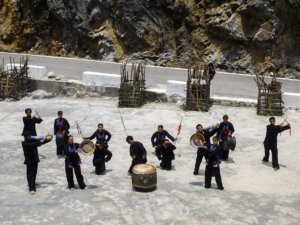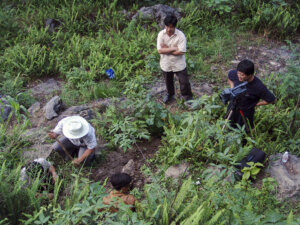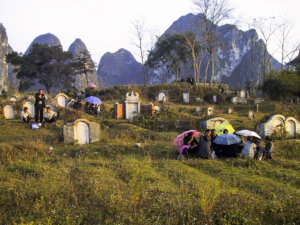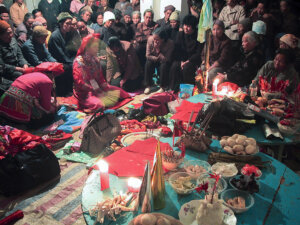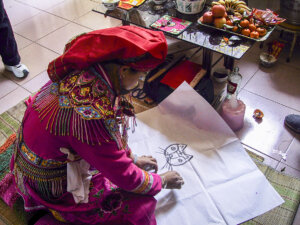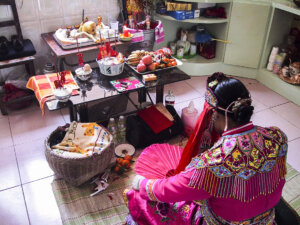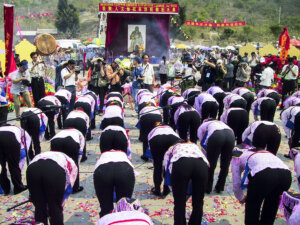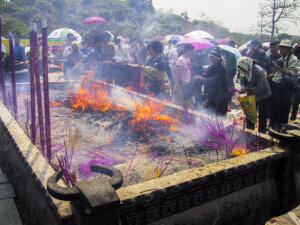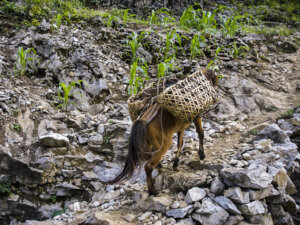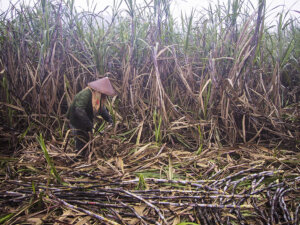The visit to the southwest mountainous areas last 6 months, during the period of which the factual living and cultural conditions such as the dressing of local nationalities, housing, legends, customs of wedding and funeral, and religious rituals, etc. are recorded in a detailed manner. In addition, 3000 thousands of photos and a video of 120 hours in length were taken and made concerning such information of Gewei Festival, Drum ritual of sacrifice, local customs of expelling evil spirits and dispelling diseases, God-worship at harvest time, loud singing of Pinggou, singing-to-our -content of Dong Nationality and so on.
Film Documentary made by a journalist and a picture photographer
Twenty years ago, I was designated to work at Air Force Base of the Southwest Mountain after graduation from the 16th Air Force Flight Academy of China People’s Liberation Army. It was a place that I could sleep with the company of folksongs in the mountain areas.
1 – Adventures in Southwest Mountainous Areas
During the seventies of the 11th century, Marco Polo, a Venetian businessman, together with his father and uncle, travelled all the way from Italy to the Middle East before they arrived in China four years later and spent another 17 years there. In the book Travels of Marco Polo written after his return to Italy, he captured his experience in China which was then under the rule of the court of Kublai Khan and his visit of Duzhou(.Now Liangshan Yi Autonomous Prefecture in Sichuan Province) and Dali in Yunnan Province and the corresponding folk-custom culture along the way. Since 1860s, China opened its door gradually to the outside world after the breakout of the Opium War and tourists, missionaries and scholars of various nationalities were attracted to conduct field investigations in southwest mountainous areas in China.
Bacot Jacques, an explorer and pioneering French Tibetologist conducted field research in Naxi Ethnic Minority Area of Lijiang City, Yunnan Province both in 1907 and 1909. In 1931, he got his work Moxie Studies published by Holland Leiden University Publishing House (Moxie (“麽些”in Chinese) refers to the former name of the nationality, replaced by Naxi officially after 1949), which indicated his position of the first western pioneering scholar on the research of Dto-mba Religion.
Joseph F. Rock, an American-Austrian botanist and explorer, had been staying in Lijiang City of Yunnan Province, China during the period between 1921 and 1949. He was supposed to conduct the collection of plant specimen as designated by United States Department of Agriculture (USDA). He was so obsessed with the research of Culture of Naxi Nationality and Dto-mba Religion that he utterly disregarded his tasks. Later on, he was recognized as Father of Naxi Studies in the Western academic circles for his remarkable achievements in the studies of Dto-mba Religion. His fieldwork was assisted with the fund provided by and sponsorship of such organizations as United States Department of Agriculture (USDA), Association of American Geographers, and Harvard Universities, etc. He bought more than 8000 volumes of Dto-mba Scriptures in Lijiang City, which were transported to America and donated to the Library of Congress, research institutes or sold to individual collectors.
As for the whereabouts of Dto-mba Scriptures collected by Rock, K.L.Janert pointed out in the Review of J.F. Rock, Na-khi Manuscripts that most of the manuscripts were lost during the period of World War II; About 4000 volumes were sold to the individuals, which were called as the collection of Heronmere; About 1000 volumes and the microfilm of a large amount of the collection of Heronmere were preserved in the Library of Congress in Washington, USA; 1000 were obtained by Yanjing College, Harvard University (located in Cambridge City of Massachussets, USA). 25 volumes were sent to Rock’s friends and acquaintances and 15 volumes of Dso-la Manuscripts were stolen in the publishing organs of China. Another 1115 volumes with Rock’s individual copied collections included were sold to Marburg National Library of Germany (the code of which is A)
During the period from July 1902 to March 1903, Dr. Torii Ryûzô, the Japanese scholar, led his inspection team to the southwest of China, the fieldwork covering 9 provinces and cities with a journey of more than 10 thousand li in distance and taking a time of seven and a half months. The inspection team, armed with cumbersome glass light-sensing cameras, kept a detailed record of the places and their corresponding topography, oil situation, plantation, and such information concerning the living condition and culture of the local nationalities as their dressing, dialects, housing, legends, customs of wedding and funeral, religious rituals, social organizations. More than 400 pictures of great value were taken while the measurements of the human and other forms of archeological investigation were carried out.
When it moved to the 20th centuries, Chinese anthropologists began to conduct scientific research on southwest mountainous areas from the second decade to the fourth one, aiming at exploring the cultural relics of ethnic minorities there. Professor Yang Chengzhi can be recommended as the first scholar of its kind concerning the research of the ethnic minorities in the Southwest of China.
2 – People in Southwest Mountainous Areas
There are 34 ethnic minorities dwelling in the Southwest Mountain of China in total, each of which boasts of its unique language, religious belief and customs left to be discovered by the outside world.
Longji Terrace had been excavated as early as in the 12th century. As one of the outstanding rice-plantation Cultural Landscapes of world level, Longji Terrace is approaching its optimum after several thousand of years’ development
3 – Zhuang Brocade
Zhuang Brocade is one of the Four Nationally Famous Brocades in China. On a manual loom containing a supportive system, a transmitter, a dividing system and a jacquard system. Zhuang Brocade textile is woven in beautiful designs with natural cotton warp and dyed velour weft.
Weaving Zhuang Brocade has become an indispensable part of life for the women of Zhuang ethnic minorities in Southwest Mountainous Areas in China, symbolizing their advanced and delicated techniques of needlecrafts. Zhuang Brocade also becomes a necessity in the trousseau for the bride-to-be.
There goes a story like this: once a girl named Danimei saw the dewdrop glittering with extraordinary splendor in the sun on the spider web. She was inspired by the vision and then used the silk thread of various bright colors as the warp and the spun yarn of primary colors as weft, knitting and weaving aboratively. There came the magnificent Zhuang Brocade. Well-developed with a long history, Zhuang Brocade owes a lot to its position in the life of the women in southwestern areas—basic means for living. But with the social development and the decomposing of the natural economy system, Zhuang Brocade is approaching the severe crisis of survival, not to speak of further evolution.
4 – Witch and Wizard
The local witches and wizards are considered as the medium of communication between the human being and God or ghosts.
Their job responsibilities involve such religious rituals as “expelling evil spirits”, “dispelling disasters”, “inviting the ghosts”, “selecting the auspicious day”, “praying for blessing”, hosting the funerals, organizing collections and festivals etc.
Witch, also called the little necromancer, is normally in dishabille while practicing witchcraft without former tutorship or classical scripture to obey. She uses gourd-like vessel (called “Ding” in Chinese) as the musical instrument and then involves herself in magic actions. The witch claims that she could travel in the world of the dead to seek the ghost who was once the relatives of the living and convey their message. She can also ask the spirits and ghosts for information to predict the fortune or misfortune in the future. Wizard, also called the master, obtains his mastership through apprenticeship not belonging to special organizations. The masters do not have to practice vegetarianism and can be married as well. Their classical writing is named as witchery scripture written in the local dialect of Zhuang nationality, containing a lot of information including folk legends, history and geography, astronomy and mathematics.
5 – Bronze Drum
As one of the oldest bronze musical instruments in the world, bronze drum remains to be one of the utensils used in sacrifice and symbolize the authority tressure for the people in southwest mountainous areas in China.Bronze drum is cast at the first attempt with the unique smelting technologies invented by the local people in southwest mountainous areas in China. With a sound of great permeability, it can let out sounds of various acoustic and percussive timbres while being knocked, which cannot have been replaced or paralleled to date. The manufacturing work craft of bronze drum was lost a hundred years ago. According to the relative statistics, there are totally 2400 bronze drums existent at present.
Bronze drums were passed from China to Europe at the end of the 19th century, where they were unknown to the people in terms of its identity or function. Driven by the interest in traditional Chinese culture, European began to conduct research on bronze drum, which had not been carried out in the place other than France and Germany by 1930s. In the seventies of the 20th century, a large amount of efforts were drawn into the research of Luoyue Culture with the assistance of national research and the leadership of Fan Wentong Premier in Vietnam, the second largest country boasting of bronze drums, aiming at the expansion of its state borders into the territory of the People’s Republic of China. The research was focused on the bronze drums with the logo of bronze drum symbolizing national soul and the territory of Vietnam stretching itself to wherever features gossampinus malabaricus. Then Sino-Vietnamese Border War was brought forth by the Vietnamese Government in 1978. In order to deal with the situation of war and its cause, Chinese government issued an order for the research of national and historical history of southwest mountainous areas in China.
6 – God-worship Tree
There is a big banyan fig in each village of southwest mountainous areas in China as the God-worship tree. Regarded as the medium of belief by the villagers, the God-worship tree plays an important role in the regular sacrifice ritual praying for the health of the offspring and the prosperity of the tribe.
Accoding to the story widely spread in the local area, after the times of Bubo (the legendary hero who fight against the king of Thunder in the Flood Fairytale of Zhuang Nationality) , it was more and more difficult for so many people to survive at the same place with the increasing of populaiton. In order that the whole tribe can futher multiply and develop, people there decided to separate for different other locations for living. Before they left, three old men put forward the questions: when they lost the clue of the whereabouts of each other, how could they and their offspring be acquainted again when they met some day afterwards and be not involved in conflicts or even war? So it was decided that three trees should be planted. The gossampinus malabaricus was planted at the peak of one mountain. When it blooms in March of spring, the reddens of the flowers all around the mountain will form the fiery-redness like that of clusters of fire; the banyan fig grew at the second mountain peak, the flourishing of which would signify the prosperity of the tribe and its offspring; At the top of a third mountain stood the maple, by using which people could dye the glutinous rice for cooking, called Jingwu glutinous rice. Later on, some other colors as yellow, red, purple, and white were also employed for the making of Wujing glutinous rice, the five colors indicating an abundant harvest of five kinds of grain (called “Wu Gu Feng Shou” in Chinese)
In southwest mountainous areas in China, every village has a banyan fig, which is considered a god-worship tree due to its being imbued with God or spirits. Thus normal people can not approach it randomly or damage or cut it down, nor can they urinate or discharge excrement or say something profane in its surrounding, still less can they have sex there. Otherwise they might be punished by the holy spirits or god with sickness or economical loss as the light means of punishment and being damaged, disabled or even violent and sudden death as the severe ones. It is usual for each village to establish a temple of around 11 square meters for the regular worship of the God of community beside the root of the god-worship tree.
7 – Folksongs of the mountainous areas
People in southwest mountainous areas are accompanied with folksongs throughout their life.
Folksongs can not only convey feelings but also thinking. They can shoulder some historical missions in the certain period of times.
Folksongs of the mountainous areas also act as the records of the thousand-year history and old-aged culture of the local people.
If you can not sing a folksong of the mountainous areas, you can only lead a life of isolation and solitude without the company of your lover, who you can not seek without the folksong. Neither can you get known to the present or the past of the area without resorting to the history record between the lines of the folksong lyrics.
People in southwest mountainous areas can sing as they wish with a rhyme in each sentence and profound meaning of the lyrics. The songs are generally featured with counterpoint. The chorus of enlarged double chords is unique out of the local people’s originality. As one of the most difficult counterpoints in the world, it once amazed the whole international music circles. It is regarded as the almost impossible chorus if deducted by voice scientifically, which turns out to be achieved with the loud and clear voice of the local people in southwest mountainous areas.
As for the origin of the Gewei Festival, there spread different types of stories. One of them goes that a couple of lovers in the ancient times were both famous singers who convey their affection of each other with the folksongs. But due to the chains of feudalism, they just died for love after they knew they could not get married. People then carried out the customs of singing on March 3 each year in honor of them. Another version tells that there is a singing fairy lady named Liu Sanjie of Zhuang Nationality, who is smart and can sing to praise highly of love and diligence or reveal the evils and sins of the land lords and the rich men. Then as the target of hatred and fear of the land lords and rich men, she fell off the cliff and was killed when chopping firewoods on the mountain on March 3 after the vines of the mountain were cut off by the man designated by the land lords. In order to commemorate the singing fairy lady, people will gather and sing highly of her for three days and nights straight, thus forming the Gewei Festival.
Called the singing festival of March 3 with a long history, Gewei Festival on March 3 of lunar calendar is one of the most important festivals for the people in Southwest Mountainous Areas. It usually lasts two or three days with the counter-singing between the male and female as the main contents, providing a wonderful place for the young people to show their affection to each other. People can sing or listen to the song at the festival and the young can find their beloved and make the love-promise through giff-gaff of faith tokens
The annual Geiwei Festival on March 3 can be treated as one of the largest fairs for the lovers in the world.
In 1999, authorized by the central government of the People’s Republic of China, the Gewei Festival on March 3 was renamed as “Nanning International Folksong Art Festival, the time of which was also changed from March to October annually. The Singing Festival of March 3 in each October is a comprehensive super music gala of international scale organized by the government composed by such items as Southeast Asian singing and dancing, European and American popular music, Brazilian Samba and so on, with the folksongs in the mountainous areas as the activities of embellishment..
8 – Water Mill
Water mill is one of the oldest traditional tools for irrigation in China.
9 – Rice
It has been proved in United Nations Food Conference that the local people in southwest mountainous areas are the inventors of the planting technologies of rice.
Now, the wild rice seeds can still be found in southwest mountainous areas.
10 – Ancestors
The shrine set in the central living room for the worship and sacrifice of ancestors and other gods like kitchen god is an inalienable part for the housing of the people in southwest mountainous areas.
In the shrine, the names of ancestors are written in capital in the central part of a piece of red paper and the names of other gods are flanked on two sides.
11 – Geomantic Omen
There used to be a lot of fishes, but now they are gone.
Once there stood the God-worship Tree. Now it was burnt and nothing could bring it back ever.
12 – Baise Basin
On September 13, 1986, Deng Xiaoping made a comment that the Pinggou project in Guangx should be carried out sooner or later.
On May 7, 1991 Pinggou Aluminum Project was officially launched.
Now I would like to claim that the explosive project organized by the Alumina Factory of Guangxi Huayin Co.Ltd is ready for start-up.
According to the local government, the aluminum base, one of the largest of its kind in Asia, will be established in the coming 5 years along the area from Baise Basin to the surrounding coastal cities all the way with Nanning City as an axis.
Liu Zhengdong, the secretary of Baise Municiple Committee of CPC in Guangxi Zhuang Nationality Autonomous Area, once said that Baise City is abundant in mine resources of various categories and large reserves.
There are 57 kinds of mines discovered to date, 34 of which have been identified and the aluminum mine of which has been found out the present aluminum storage of 700 million tons and promising storage of 1 billion tons.
Guo Shengkun, the secretary of CPC Committee of Guangxi Zhuang Nationality Autonomous Area, once remarked that the strategy of Aluminum industry development in Guangxi should be the establishment of a complete industry chain featuring such items from primary production to the advanced processing of aluminum stretched along the area from Baise to the surrounding coastal cities with Nanning as the axis. The arrangement has been scheduled and the largest aluminum base in Asia will be built up in the coming 5 years.
Meanwhile, Aluminum Foil Business and Canadian Aluminum Group, the two giants of aluminum industry, have set up their offices successively in Guangxi. Aluminum Foil Business is planning to merger 50% of the shares of Pinggou Aluminum Corporation in Guangxi, the largest aluminum base in Asia. Canadian Aluminum Group has shut down its branches in Britain and France and is going to promote the project of highly-sophisticated aluminum composite panel in Nanning. In addition to this, FOXCONN will make an investment of around 3 billion USA dollars (23.4 billion Hong Kong dollars) with deep processing of aluminum materials as one of the key projects for development in Nanning.
Now I would like to announce the opening of the 2006 Baise Buluotuo Nationality Cultural and Tourist Festival.
According to the report released by Sciences of America in 2001, the stratigraphical age of the Primitive Human Being Relics of Baise Basin in China can be dated back to as early as 803,000 years ago, labeling itself as one of the earliest primitive human being relics in the world. Encouraged by this, many a scholar comes to Baise Basin for field investigation. The legends on the ancestors of Buluotuo Nationality in southwest mountainous areas are widely spread. In 2002, a poet in Guangxi was inspired by the fact that the character “Gan”( “敢”in written Chinese) in the local dialect of Zhuang nationality in Tianyang means “Gewei”(“歌圩”in written Chinese) and then located Ganzhuang Mountain of Tianyang as the earliest relics of sacrifice for Buluotuo Nationality in southwest mountainous areas.
13 – Gejie Wine (Gejie, “蛤蚧” in Chinese, refers to a kind of reptile named phrynosoma)
The medicine wine of Gejie made by mixing wild phrynosoma and wine can provide great effect on the fitness of and disease dispelling for human being. It can also be used for strengthening Yang-qi in traditional Chinese medicine.
Is this buckwheat? Yes, its output is small and it can stand coldness. Together with corn, it is one of the main food for the local people.
14 – Sight-seeing vehicles
After the development of the scenery zone, a documentary once was shot here by CCTV. They asked for sponsorship of one Hope Primary School for the local children through the TV programs. Now students in the school can see and solute to the sight-seeing vehicles on the way between the school and their home, indicating their kindness and warm welcome to the tourists. They regard that with the development of the mountain and the arrival of tourists, their living and studying conditions become better and better.
15 – Fresco on Huashan Mountain
Remedy Project of Fresco of Huashan Cliff: mystery of thousands of years.
Fresco of Huashan Cliff was drawn on the steep cliffs facing the river, 40 meters in height and 220 meters in width. It features portraits of more than 1900 people with 1300 ones of adults, among which the largest is 3 meters and the slightest 30 centimeters in height. Every portrait was achieved by using red pigment with abstract emblem
16 – Taoist Rites
Taoist Rites are conducted by the taoist master to conduct such activities as reciteing the scipture or making confession for the deceased, surpassing the soul of the dead, worshiping the gods, rewarding the gods for harvest, praying to Granny Flower(a goddess of Zhuang nationality in charge of the fecundity of human being) for a son or expel the ghosts or dispel the disease.
Taoist master is generally the semi-professional farmer. They can get married and do not to carry on their cultivation of vital energy or make pills of immortality. They just do not eat the flesh of dog or beef. Everything is the same as the ordinary people with Taoist master except that he is asked to conduct Taoist Rites with his scripture, cassock and drums. Each Taoist rite will last a period between one day and five days with scripture-reciting or drumming all day and all night. The Taoist scriptures include Taiping Scripture, Lingbao Scripture, Sanhuang Scripture, Yinfu Scripture and Tai Shang Gan Ying Scripture ect. The hand-written copies owned by Taoist masters vary a lot from the official Taoist scripture in its contents, the former of which are interspersed with a lot of folksongs written in the dialect of Zhuang Nationality like song of filial piety, song of grace and righteousness, song of morality and so on. Some even contains the beliefs of Buddhism.
Concluding notes
Except some ethnic minorities in the deep area of the mountain, most of the tribes have been assimilated. They don’t know the connotation and original meaning of “big banyan fig” and Granny Flower (a goddess of Zhuang nationality in charge of the fecundity of human being); they can not sing the folksong of the mountainous areas. They know that bronze drums are historical relic. They don’t know or read their language solely used by their ancestors, but they have a passion for pop music or street funk.


